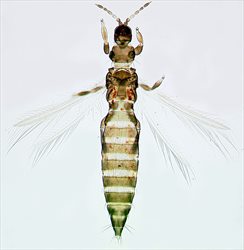
Female
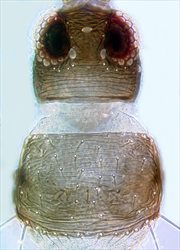
Head & pronotum

Antenna

Antenna
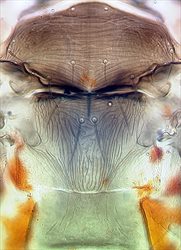
Meso & metanota
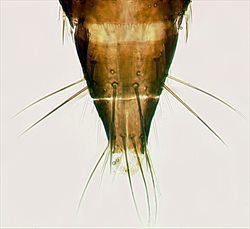
Tergites VIII-X

Tergites VIII-IX
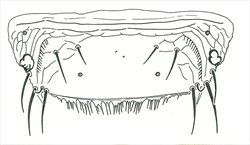
Tergite VIII

Fore wing
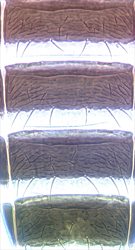
Female sternites IV-VII
Both sexes either fully winged or micropterous. Body and legs brown, tarsi light brown, antennal segment III yellow to yellowish brown, IV light brown; fore wings shaded. Antennae 8-segmented; III–IV with forked sense cone. Head with 2 pairs of ocellar setae; pair III no longer than side of ocellar triangle, arising just outside the triangle; postocular setae pairs I & III slightly longer than ocellar setae III, postocular setae pair II minute. Pronotum with 2 pairs of posteroangular setae; posterior margin with 3, or more usually 4, pairs of setae. Mesonotum with paired anterior campaniform sensilla; median setae arise well in front of posterior margin. Metanotum with longitudinal striae converging to posterior, but irregular around median setal bases with faint markings between these striae; median setae arising close together behind anterior margin; campaniform sensilla absent. Fore wing setae relatively long, first vein with 5–10 setae on distal half; second vein with about 12 setae. Abdominal tergite II with 3 lateral marginal setae; tergites V–VIII with paired ctenidia, on VIII posteromesad to spiracles; tergite VIII posteromarginal comb variable, sometimes with complete almost regular comb, but microtrichia often arising in groups, and more rarely apparently absent; pleurotergites with no discal setae, posterior margin with dentate microtrichia; tergite IX with 2 pairs of campaniform sensilla, X with median split. Sternite II with 1–3 discal setae, III–VII with 7–15 discal setae in irregular double rows; sternite VII marginal setae S1 arise in front of margin.
Male smaller than female; tergite VIII with no posteromarginal comb; tergite IX median setae slender; sternites III–VII with large oval pore plate.
The genus Thrips is the second largest genus in the Thysanoptera, and currently includes, worldwide, over 290 species. All members of genus Thrips lack ocellar setae I on the head, and they all have ctenidia on tergite VIII posteromesad to the spiracles. Other characters, such as number of antennal segments, number of setae on the fore wing veins, and number of discal setae on the sternites are variable between species (Palmer, 1992; Nakahara, 1994; Mound & Masumoto, 2005). Although Thrips angusticeps has discal setae on the sternites but not the pleurotergites, it is unusual amongst species that share those character states in commonly being micropterous, and the fore wings when developed often have numerous setae on the first vein.
Feeding and breeding in the flowers of its host plants; apparently polyphagous though associated particularly with species of Brassicaceae.
In Britain, recorded mainly from the southern half of England and from Yorkshire, but there are also several records from Aberdeenshire (Mound et al., 1976). The species is widespread across Europe.
THRIPIDAE - THRIPINAE
Thrips angusticeps Uzel
Thrips angusticeps Uzel, 1895: 191
Achaetothrips loboptera Karny, 1908: 111
Bagnallia asemus Williams, 1913: 223
Thrips ebneri Karny, 1914: 54
Thrips paucisetosus Priesner, 1927: 401
Mound LA & Masumoto M (2005) The genus Thrips (Thysanoptera, Thripidae) in Australia, New Caledonia and New Zealand. Zootaxa 1020: 1–64.
Mound LA, Morison GD, Pitkin BR & Palmer JM (1976) Thysanoptera. Handbooks for the Identification of British Insects 1 (11): 1–79.
Nakahara S (1994) The genus Thrips Linnaeus (Thysanoptera: Thripidae) of the New World. United States Department of Agriculture. Technical Bulletin 1822: 1–183.
Palmer JM (1992) Thrips (Thysanoptera) from Pakistan to the Pacific: a review. Bulletin of the British Museum (Natural History) Entomology Series 61 (1): 1–76.